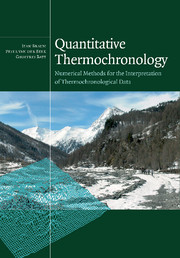Book contents
- Frontmatter
- Contents
- Preface
- 1 Introduction
- 2 Basics of thermochronology: from t–T paths to ages
- 3 Thermochronological systems
- 4 The general heat-transport equation
- 5 Thermal effects of exhumation
- 6 Steady-state two-dimensional heat transport
- 7 General transient solution – the three-dimensional problem
- 8 Inverse methods
- 9 Detrital thermochronology
- 10 Lateral advection of material
- 11 Isostatic response to denudation
- 12 The evolution of passive-margin escarpments
- 13 Thermochronology in active tectonic settings
- Appendix 1 Forward models of fission-track annealing
- Appendix 2 Fortran routines provided with this textbook
- Appendix 3 One-dimensional conductive equilibrium with heat production
- Appendix 4 One-dimensional conductive equilibrium with anomalous conductivity
- Appendix 5 One-dimensional transient conductive heat transport
- Appendix 6 Volume integrals in spherical coordinates
- Appendix 7 The complementary error function
- Appendix 8 Pecube user guide
- Appendix 9 Tutorial solutions
- References
- Index
11 - Isostatic response to denudation
Published online by Cambridge University Press: 15 December 2009
- Frontmatter
- Contents
- Preface
- 1 Introduction
- 2 Basics of thermochronology: from t–T paths to ages
- 3 Thermochronological systems
- 4 The general heat-transport equation
- 5 Thermal effects of exhumation
- 6 Steady-state two-dimensional heat transport
- 7 General transient solution – the three-dimensional problem
- 8 Inverse methods
- 9 Detrital thermochronology
- 10 Lateral advection of material
- 11 Isostatic response to denudation
- 12 The evolution of passive-margin escarpments
- 13 Thermochronology in active tectonic settings
- Appendix 1 Forward models of fission-track annealing
- Appendix 2 Fortran routines provided with this textbook
- Appendix 3 One-dimensional conductive equilibrium with heat production
- Appendix 4 One-dimensional conductive equilibrium with anomalous conductivity
- Appendix 5 One-dimensional transient conductive heat transport
- Appendix 6 Volume integrals in spherical coordinates
- Appendix 7 The complementary error function
- Appendix 8 Pecube user guide
- Appendix 9 Tutorial solutions
- References
- Index
Summary
This chapter investigates the effect of isostatic rebound caused by surface erosion on the distribution of thermochronological ages at the surface of the Earth. We demonstrate that age–elevation relationships contain information on the nature of this isostatic response, i.e. on the degree of flexural compensation, and can, in effect, be used to provide constraints on the effective elastic thickness of the continental lithosphere.
Local isostasy
The post-orogenic phase of most mountain belts is characterised by a gradual erosion of the topography created during the active tectonic phase. This erosion results in unloading of the underlying lithosphere and consequent isostatic adjustment. The principle of isostasy assumes that there is a region beneath the lithosphere (the compensation depth) where rocks are so weak that they cannot sustain any horizontal stress gradient over geological times, and hence the region adjusts to imposed loads by deformation. This implies that, at isostatic equilibrium, the weight of adjacent lithospheric columns must be equal. Erosion of surface topography results in a local reduction of the weight of the underlying lithospheric column and must therefore be compensated by vertical uplift.
As shown in Figure 11.1, surface erosion by an amount E0 (panel (b)) of a reference lithospheric column (panel (a)) of crustal thickness hc and total thickness hc + L results in an isostatic surface uplift by an amount u (panel (c)) such that the weights of the two columns ((a) and (c)) down to the compensation depth hc + L are identical.
- Type
- Chapter
- Information
- Quantitative ThermochronologyNumerical Methods for the Interpretation of Thermochronological Data, pp. 164 - 176Publisher: Cambridge University PressPrint publication year: 2006

